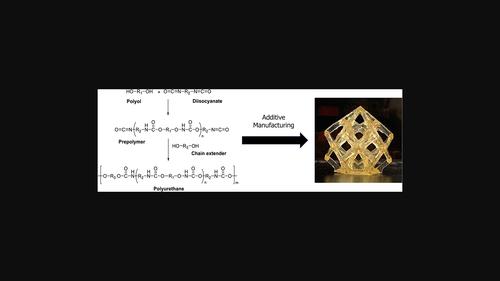求助PDF
{"title":"Recent trends in the additive manufacturing of polyurethanes","authors":"Ren H Bean, Timothy E Long","doi":"10.1002/pi.6584","DOIUrl":null,"url":null,"abstract":"<p>Polyurethanes are remarkably versatile materials that offer exceptional control over structure–property relationships, making them the subject of extensive research and exploration across diverse applications. These materials have garnered significant attention due to their inherent chemical, mechanical, thermomechanical, biological and physical properties, further fueling interest in their potential uses. However, conventional processing methods, involving molds, high temperatures or solvents, impose limitations on geometric complexity, hindering their potential applications. Additive manufacturing, or 3D printing, has emerged as a transformative solution, enabling the fabrication of intricate geometries, unparalleled design flexibility, dematerialization and enhanced material properties. This mini-review explores recent advancements in additive manufacturing techniques applied to polyurethanes, focusing on three prominent 3D printing modalities: vat photopolymerization, direct ink write and fused filament fabrication. Examining the successful integration of polyurethanes with these cutting-edge 3D printing methods illuminates the remarkable progress achieved in tailoring part design, expanding the range of applications and unlocking novel material−object functionalities. This mini-review aims to provide valuable insight into the latest trends and development in 3D printing polyurethanes, paving the way for their future utilization in diverse industries. © 2023 Society of Chemical Industry.</p>","PeriodicalId":20404,"journal":{"name":"Polymer International","volume":null,"pages":null},"PeriodicalIF":2.9000,"publicationDate":"2023-10-23","publicationTypes":"Journal Article","fieldsOfStudy":null,"isOpenAccess":false,"openAccessPdf":"","citationCount":"0","resultStr":null,"platform":"Semanticscholar","paperid":null,"PeriodicalName":"Polymer International","FirstCategoryId":"92","ListUrlMain":"https://onlinelibrary.wiley.com/doi/10.1002/pi.6584","RegionNum":4,"RegionCategory":"化学","ArticlePicture":[],"TitleCN":null,"AbstractTextCN":null,"PMCID":null,"EPubDate":"","PubModel":"","JCR":"Q2","JCRName":"POLYMER SCIENCE","Score":null,"Total":0}
引用次数: 0
引用
批量引用
Abstract
Polyurethanes are remarkably versatile materials that offer exceptional control over structure–property relationships, making them the subject of extensive research and exploration across diverse applications. These materials have garnered significant attention due to their inherent chemical, mechanical, thermomechanical, biological and physical properties, further fueling interest in their potential uses. However, conventional processing methods, involving molds, high temperatures or solvents, impose limitations on geometric complexity, hindering their potential applications. Additive manufacturing, or 3D printing, has emerged as a transformative solution, enabling the fabrication of intricate geometries, unparalleled design flexibility, dematerialization and enhanced material properties. This mini-review explores recent advancements in additive manufacturing techniques applied to polyurethanes, focusing on three prominent 3D printing modalities: vat photopolymerization, direct ink write and fused filament fabrication. Examining the successful integration of polyurethanes with these cutting-edge 3D printing methods illuminates the remarkable progress achieved in tailoring part design, expanding the range of applications and unlocking novel material−object functionalities. This mini-review aims to provide valuable insight into the latest trends and development in 3D printing polyurethanes, paving the way for their future utilization in diverse industries. © 2023 Society of Chemical Industry.


 求助内容:
求助内容: 应助结果提醒方式:
应助结果提醒方式:


